While we’re underwhelmed by the vision announced on Sunday of a roads first harbour crossing, far more interesting is the vision for the waterfront being pushed by Mayor Wayne Brown and the council that was released last week.
At a series of confidential workshops, council staff, independent advisors Flagstaff Partners, GHD Engineering and Eke Panuku discussed the draft findings of land release options for waterfront land.
The independent advisors and Eke Panuku presented a high-level preliminary feasibility study which identified the possible first stage of land release, redevelopment options and commercialisation opportunities.
“I want us to deliver to Auckland the most beautiful and loved publicly owned waterfront of any harbour city in the world, and this is a first step,” Mayor Brown said.
Stage one of the release would focus on the redevelopment of the central wharves – Queens Wharf, Captain Cook Wharf, Marsden Wharf, and the Hobson Wharf extension – for a mix of uses, activities and development with Bledisloe Wharf to follow in the not too distant future.
“I have strong public support for getting more public access to the harbour. By freeing up and developing these valuable waterfront spaces, we have an opportunity to create a world-class arts, culture and entertainment destination that celebrates our identity and evokes pride in Aucklanders.
“We can create an open space that interacts with the harbour with the potential for an urban beach or tidal pool where people can actually touch the water, while housing a water-based amphitheatre for maritime events and activities that will attract thousands of local and international visitors. It also has the potential for an international event and exhibition venue and a Te Ao Māori showcase centre, to celebrate our rich cultural heritage.
“I’m pleased with the progress made on this work so far, which is indicating that there is a pathway to return a portion of land back to public use within the next 2 to 5 years without undermining the Port operation, while delivering significant wellbeing benefits for Aucklanders.
The concepts include ideas like salt water swimming pools, a seaside amphitheatre and exhibition centre
Eke Panuku has been doing the initial work on conceptual plans and have released the presentation they gave to the council. As they highlight, the remaining port land is huge, about twice the total area as Wynyard Quarter, where the vision for it was first established in 2005 and is still expected to take another 10-15 years to complete. A lot will also depend on long term location of the port.
Given the size, Eke Panuku suggest it might take until 2060-2080 to fully develop. However it won’t happen all in one go and any redevelopment will start with the remaining finger wharves, which are also the ones closest to the city centre, being right across from Britomart. As noted in the release, it could be freed up in 2-5 years.
 A few other interesting things from the presentation include that the pipeline of projects in the city centre could add around 640,000m² of office space, which is around a 42% increase on what we have now.
A few other interesting things from the presentation include that the pipeline of projects in the city centre could add around 640,000m² of office space, which is around a 42% increase on what we have now.
And that assuming a typical allocation of land towards public open space, we’d add about 16 Ha to Auckland’s waterfront.
Given past discussions, one thing Eke Panuku say this about the prospect of a stadium.
A city centre stadium would provide many benefits to the city.
But in order to realise these benefits, it needs to be based in the best location – not all city centre locations are equal.
We have concluded that none of the sites within port land are suitable.
All of this is of course only at a very early stage and a lot more detail needs to be worked though, not least of which is how the development will respond to climate change given most of the area would be subject to costal inundation with a 1.5m sea level rise.
The council and Mayor are saying there will be “a significant public consultation process before any further progress is made” but it’s great for the city to be able to have discussion about the vision for the future.
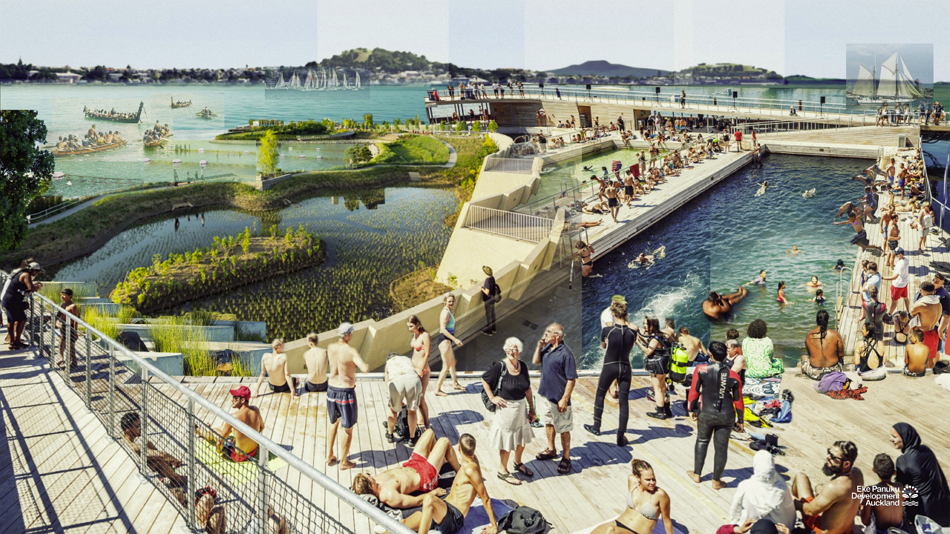
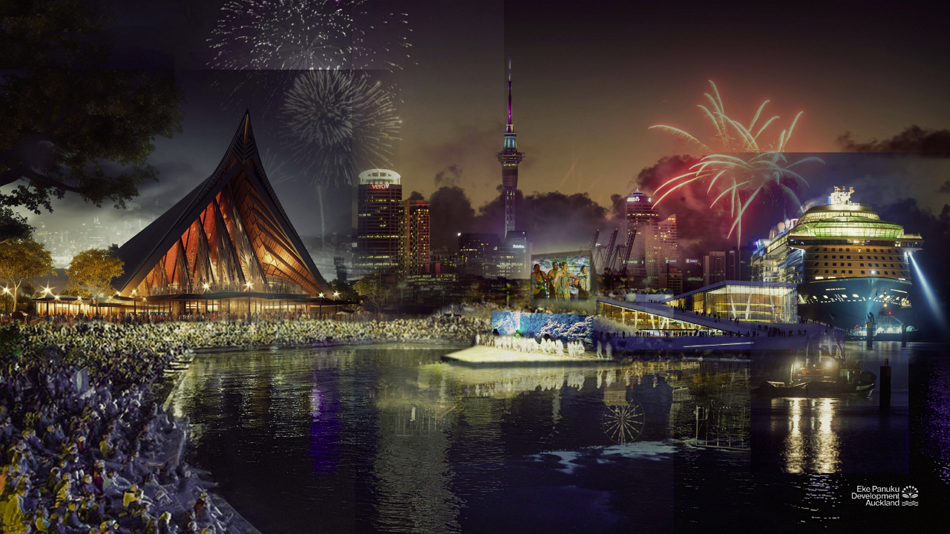
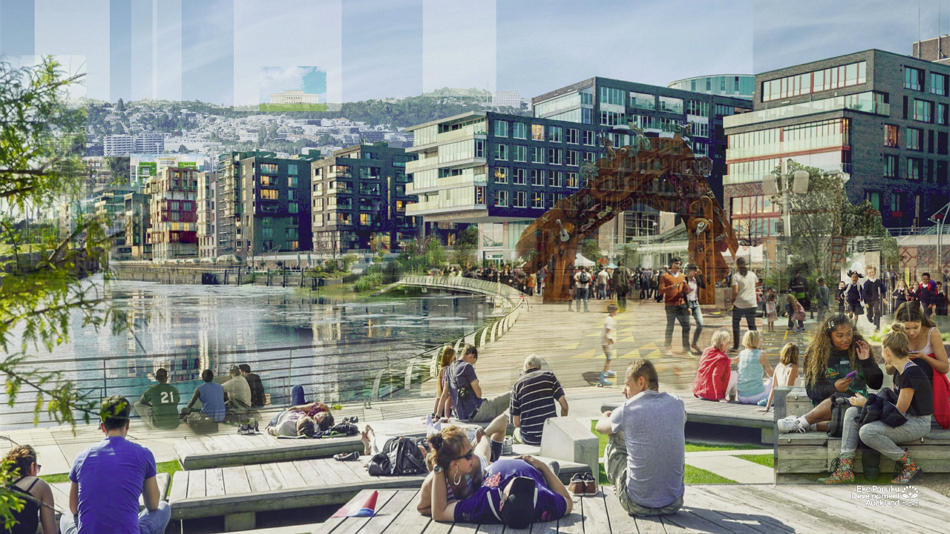
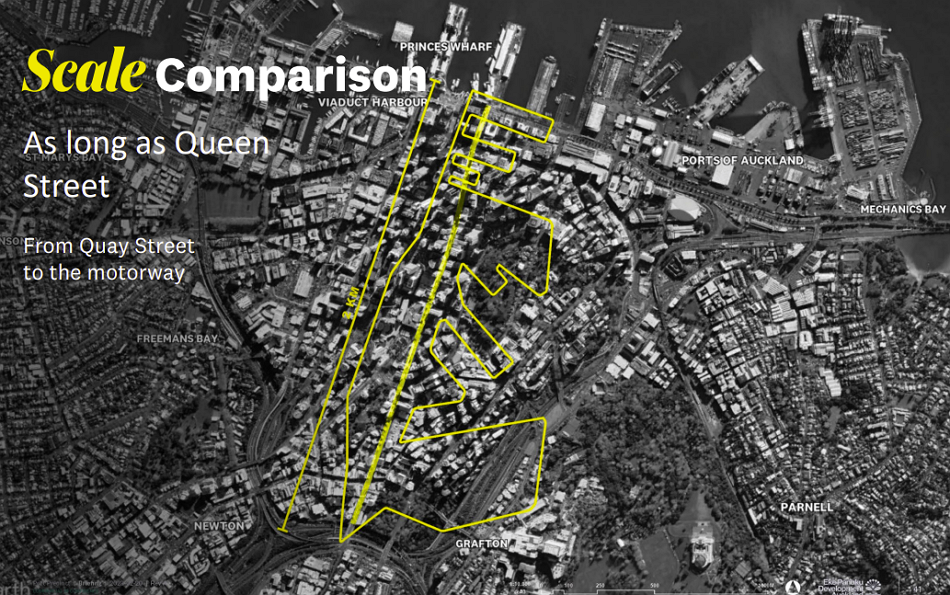
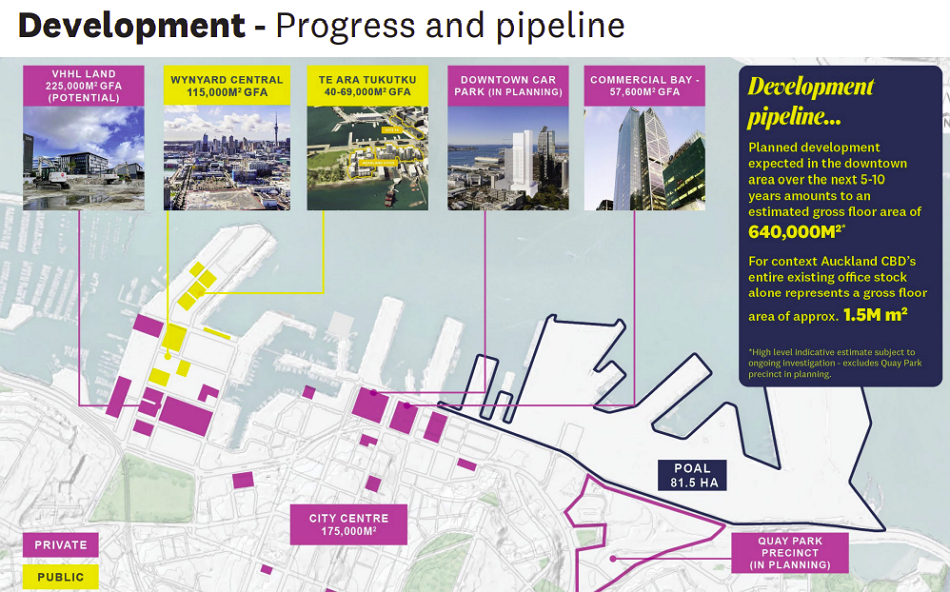
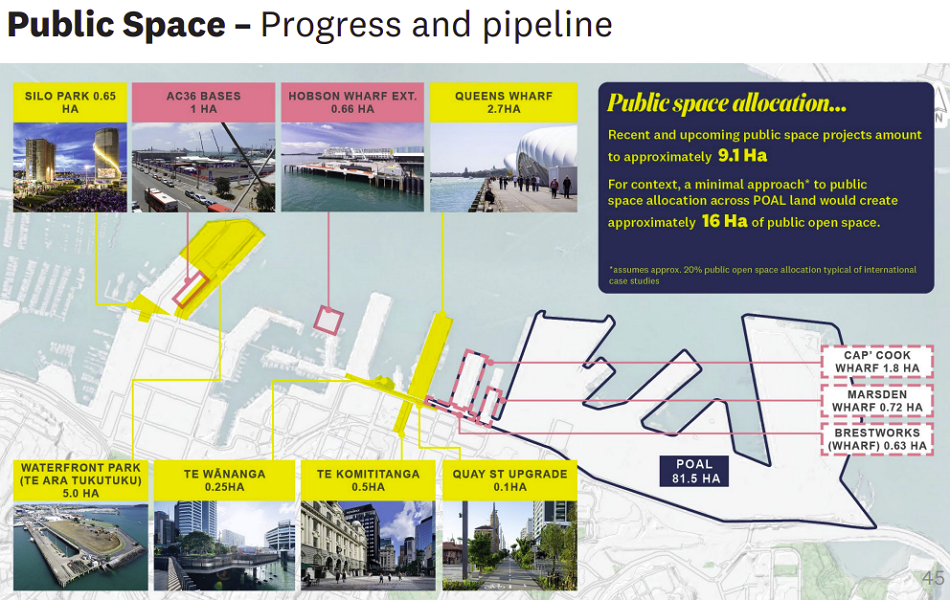

 Processing...
Processing...
In image 3, is that Selwyn Muru’s Te Waharoa o Aotea I see?
Are they planning on moving it from Aotea Square to the waterfront? Or is that just some strange rendering asset that they threw in?
Interesting to see that one of the two things currently in planning for this new exciting public space waterfront is the “Downtown Car Park”.
Caused me internal screaming.
But I have to acknowledge it is consistent with the idea of the city as a destination, rather than a conduit for through traffic.
“Redevelopment of…” surely?
I thought the old carpark was being demolished and replaced with another skyscraper? It’s talking about that I believe. Although it will still be in the best commercial interests of the commercial bay precinct to retain a large amount of easy public parking.
Based on… what?
It’s in their interests to make sure the nearby streets are as welcoming as possible for people, and the corridors into town move people efficiently, that is, are not clogged with space-inefficient vehicles attracted by easy parking.
Retaining a large amount of easy public parking is the worst thing they can do for their own commercial interest.
Based on the fact that Sylvia Park, Westfield Newmarket, St Lukes, Glenfield Mall etc also exist and provide copious amounts of free and easily accessible parking.
For those that see shopping as a chore (perhaps 70% of the general population and 95+% of people who have to go shopping with their kids), they just want their shopping to be over and done with.
Dragging multiple shopping bags + 2 tired children in and out of town on the bus or train is less convenient than getting in a car and driving – even if that involves sitting in 15 min of traffic.
Commercial bay is my #1 preferred mall because it has good food, an easy layout, is not too crowded, and is accessible both by car and public transport depending on how busy i am + what other chores I need to do that day. If i have a relaxed schedule I will choose to catch the bus or train, but if I have to go shopping and then hurry off elsewhere in the city, I will drive or ride. If I can no longer park next to the mall, I will simply go to a different mall (probably Newmarket or st lukes).
We all know you love public transport, however unfortunately the car is still more convenient for getting maximum chores done in minimum time.
Of course there is the other demographic – destination shoppers who want to enjoy their time and possibly have lunch + wine and beer – who are the best customers for commercial bay. These people can and will still come on public transport. Though I cannot see why retaining the downtown carpark will make these customers avoid the area.
Of course there’s something like 50,000 carparks in the city centre. Maybe 20,000 of those publicly available so there’s no shortage at all. There’s places like Sylvia Park that show drivers are Quite happy to walk quite a way from their car park to the shops. That downtown car park is gone burgers and we will have a much better City Centre for everyone and especially the 40k residents who live here. They seem to often be ignored by some commentators.
It’s a joke they allowed car parking under Com bay given that lower Albert is meant to be the bus hub of the city.
So you get loads of cars turning into Albert blocking things and generally causing congestion, particularly on Customs from the north.
Why can’t we ever just make things properly function for one thing?
We always have to give in to the motor vehicle whether it be “shared spaces” or “bus only” lanes.
M_C_, err no.
No city centre business competes with suburban malls on the basis of ease of parking, nor should any try, that path lies madness. They would always lose.
No, the city centre has instead other Unique Selling Points (as they say in the biz), never waste your energy playing your competitions’ game, focus on your advantages.
Vibrancy, buzz, specialist offers, real place quality, one-of-a-kind cultural attractions and events, authentic people streets not bogus aircon and flouro chain store malls, and of course the best PT access of the whole city, ie the freedom to leave the machine and motorways behind.
Easy to drive to and park at is a poor substitute for being a place people actually want to be at.
In fact if your city centre isn’t hard to access by car and still crowded you’re doing it wrong. And the crowds are back in the city centre.
i stay away from Aucklands CBD because of the amount of traffic.
One day i’ll visit…
I agree with this sentiment, but do you think there are enough people in Auckland who care enough about these unique selling points to travel to commercial bay if they can’t conveniently park?
I, for one, go to commercial bay because of these points, but my partner and I will be going a lot less often when the downtown carpark is closed.
I actually find I have to walk less going to commercial bay than sylvia park because the downtown carpark is smaller, and generally have an easier time finding a park there too.
I agree that the city centre should prioritise public transport, but the loss of some shoppers in the short term will be an inevitable consequence. In the long term it will make things better, but I also understand that some businesses cannot survive the ~5 years in between.
Did Eke Panuku get Cold WarSteve in to do those graphics? https://www.coldwarsteve.com/2023/05/01/the-cold-war-steve-giant-may-day-and-coronation-foldable-triptych-postcard/
That Cold War Steve thing is absolutely weird. Eke Panuku vision admittedly similar, but arguably slightly less weird.
But I’m puzzled over the need for these artificial reefs and decks and beaches – Auckland already has a great number of existing, completely natural beaches, safe swimming areas, and mostly pollution-free places to swim. Why would anyone need to spend millions and zillions to create artificial versions of the real things that already exist nearby, naturally?
Agree. Do we get much value from the nearby Parnell Baths these days?
Yes. If you go to Parnell Baths in summer it’s full of people. It’s the longest and deepest stretch of water for lane swimming. A fantastic place long neglected no doubt with the intention to close it. Thus denying the less well off citizens and their children of yet another public amenity. The length of time it is closed as with Pt Erin is a concern however.
It’s what I particularly like about the plan. Places to cool off at lunchtime are also a key part of climate adaptation. There isn’t time in a one hour lunchbreak to head to the beaches and come back.
I’m not alone in wanting a super-easy walk to a swimming spot – it can make or break a location for living or working.
Mayor browns overall goal is still to move auckland port to Northport it seems. Can’t say I disagree
He’s got to get the NAL open first
2060 – 2080?
Won’t this area be reclaimed by the ocean a few decades before then?
All of the current mayor’s ideas are just a continuation of the dodgy business deals he is famous for up north.
Fantastical and straight out of the 1920s, 30s, 40s; before the automobile took over.
Yes lovely, but first de-carbon-ate, so we can all breathe a little less monoxide?
And perhaps making it less difficult to build quality apartments in the central city would mean more people would choose to live centrally?
And have it wiped out by a tsunami.
It amazes me how mayors have to have a monument to themselves after they leave office. Michael Fowler in Wellington springs to mind
Looking at that how can Auckland afford it if the Mayor says Auckland is BROKE , r is he going to dig into his pocket to pay for it ? .
Auckland already owns the land, and would make money developing it.
How can you make money if you are using Ratepayers Money , the only ones that will make money from it are the Contractors doing the work on it .
It’s pretty simple.
Ports of Auckland returns a dividend of about $15m a year to the owners of the land, Auckland Council, from occupying 18.5 hectares of central city waterfront land, conservatively valued at $1.1 billion dollars. That is a return on investment back to ratepayers of around 1%.
If Auckland Council leased that land for development at market rates, like it now does with our land holdings in the Wynyard, it would increase that return to ratepayers by three or four fold, making us forty of fifty million a year, plus create hundreds of new rating units paying rates and spreading the rates burden (which the port does not).
Image 3 looks like it could be Dunedin/Wellington.
It’s a lovely vision but how will it be paid for? I am skeptical on that volume of office development being remotely likely, given wider economic factors, WFH etc etc.
These kinds of Mayors (and all mayors really) don’t mind raising rates for things they see as worth it. Ie Mauger in christchurch spending the better part of a billion on the new stadium.
And they like to get there name on a plague even though that had nothing to with it .
Example , Britomart transport centre , Les Mills and Christine Fletcher got it under way and who got their name on the plaque John Banks and the Same with the CRL it will Wayne Brown [ if he still there ] not Len Brown who did the hard yards to get it under way .
City Centre residents group have always supported the repurposing of the central wharves since that strategy came out in 2015. reclaiming more of Queens wharf for public use with that great axis/access down Queen Street/Waihorotiu has always been high on our agenda. one of the main reasons we opposed the mooring dolphins, which would’ve tied up Queens wharf with cruise ships for decades. New big reality, and IF is the sea level rise. EkeP say they have realistic projections and planning for Te Ara Tuku2 includes overtopping and flood acceptance/mitigation design. CCRG support this work going on to implement the City Centre master plan vision
Opening up of the finger wharves can’t come soon enough.
I would just leave Queens Wharf as a transport hub and a hive of activity. The Cloud needs to go though because it’s too cluttered with it remaining there. This would allow people to access the open space better.
Open up Captain Cook for a green space – its severely lacking down that part of town (if not the entire downtown waterfront). Playground too, perhaps.
I thought Marsden needed demolishing? Same treatment, perhaps with a link bridge between the two.
Yes it would be removed and cook extended for cruise
vision ! it looks great !!
i thought we were in austerity mode, panuku was to be deep sixed etc
More please
Imagery looks great, nice vision. Could this be Wayne Brown’s legacy…
Looking at Wayne Brown he will be dead before it’s either started or finished .
Interesting. I thought the dividend was around $50m?
Question to Riccardo, above.
They have paid $50m in the past at the height of profitability, but it’s all over the place. Last year it was $10m and the year before just $2m. Recent average is about $15m.